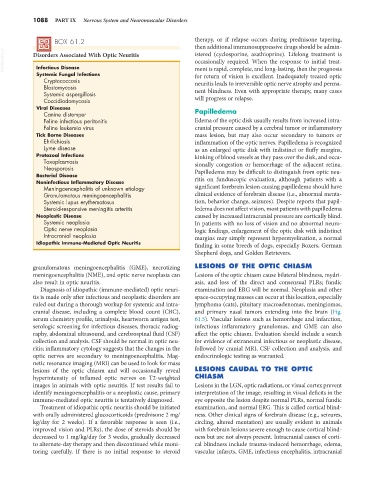Page 1116 - Small Animal Internal Medicine, 6th Edition
P. 1116
1088 PART IX Nervous System and Neuromuscular Disorders
BOX 61.2 therapy, or if relapse occurs during prednisone tapering,
then additional immunosuppressive drugs should be admin-
VetBooks.ir Disorders Associated With Optic Neuritis istered (cyclosporine, azathioprine). Lifelong treatment is
occasionally required. When the response to initial treat-
Infectious Disease
Systemic Fungal Infections ment is rapid, complete, and long-lasting, then the prognosis
for return of vision is excellent. Inadequately treated optic
Cryptococcosis neuritis leads to irreversible optic nerve atrophy and perma-
Blastomycosis
Systemic aspergillosis nent blindness. Even with appropriate therapy, many cases
Coccidiodomycosis will progress or relapse.
Viral Diseases
Canine distemper Papilledema
Feline infectious peritonitis Edema of the optic disk usually results from increased intra-
Feline leukemia virus cranial pressure caused by a cerebral tumor or inflammatory
Tick Borne Diseases mass lesion, but may also occur secondary to tumors or
Ehrlichiosis inflammation of the optic nerves. Papilledema is recognized
Lyme disease as an enlarged optic disk with indistinct or fluffy margins,
Protozoal Infections kinking of blood vessels as they pass over the disk, and occa-
Toxoplasmosis sionally congestion or hemorrhage of the adjacent retina.
Neosporosis
Bacterial Disease Papilledema may be difficult to distinguish from optic neu-
Noninfectious Inflammatory Disease ritis on funduscopic evaluation, although patients with a
Meningoencephalitis of unknown etiology significant forebrain lesion causing papilledema should have
Granulomatous meningoencephalitis clinical evidence of forebrain disease (i.e., abnormal menta-
Systemic lupus erythematosus tion, behavior change, seizures). Despite reports that papil-
Steroid-responsive meningitis arteritis ledema does not affect vision, most patients with papilledema
Neoplastic Disease caused by increased intracranial pressure are cortically blind.
Systemic neoplasia In patients with no loss of vision and no abnormal neuro-
Optic nerve neoplasia logic findings, enlargement of the optic disk with indistinct
Intracranial neoplasia margins may simply represent hypermyelination, a normal
Idiopathic Immune-Mediated Optic Neuritis finding in some breeds of dogs, especially Boxers, German
Shepherd dogs, and Golden Retrievers.
granulomatous meningoencephalitis (GME), necrotizing LESIONS OF THE OPTIC CHIASM
meningoencephalitis (NME), and optic nerve neoplasia can Lesions of the optic chiasm cause bilateral blindness, mydri-
also result in optic neuritis. asis, and loss of the direct and consensual PLRs; fundic
Diagnosis of idiopathic (immune-mediated) optic neuri- examination and ERG will be normal. Neoplasia and other
tis is made only after infectious and neoplastic disorders are space-occupying masses can occur at this location, especially
ruled out during a thorough workup for systemic and intra- lymphoma (cats), pituitary macroadenomas, meningiomas,
cranial disease, including a complete blood count (CBC), and primary nasal tumors extending into the brain (Fig.
serum chemistry profile, urinalysis, heartworm antigen test, 61.5). Vascular lesions such as hemorrhage and infarction,
serologic screening for infectious diseases, thoracic radiog- infectious inflammatory granulomas, and GME can also
raphy, abdominal ultrasound, and cerebrospinal fluid (CSF) affect the optic chiasm. Evaluation should include a search
collection and analysis. CSF should be normal in optic neu- for evidence of extraneural infectious or neoplastic disease,
ritis; inflammatory cytology suggests that the changes in the followed by cranial MRI, CSF collection and analysis, and
optic nerves are secondary to meningoencephalitis. Mag- endocrinologic testing as warranted.
netic resonance imaging (MRI) can be used to look for mass
lesions of the optic chiasm and will occasionally reveal LESIONS CAUDAL TO THE OPTIC
hyperintensity of inflamed optic nerves on T2-weighted CHIASM
images in animals with optic neuritis. If test results fail to Lesions in the LGN, optic radiations, or visual cortex prevent
identify meningoencephalitis or a neoplastic cause, primary interpretation of the image, resulting in visual deficits in the
immune-mediated optic neuritis is tentatively diagnosed. eye opposite the lesion despite normal PLRs, normal fundic
Treatment of idiopathic optic neuritis should be initiated examination, and normal ERG. This is called cortical blind-
with orally administered glucocorticoids (prednisone 2 mg/ ness. Other clinical signs of forebrain disease (e.g., seizures,
kg/day for 2 weeks). If a favorable response is seen (i.e., circling, altered mentation) are usually evident in animals
improved vision and PLRs), the dose of steroids should be with forebrain lesions severe enough to cause cortical blind-
decreased to 1 mg/kg/day for 3 weeks, gradually decreased ness but are not always present. Intracranial causes of corti-
to alternate-day therapy and then discontinued while moni- cal blindness include trauma-induced hemorrhage, edema,
toring carefully. If there is no initial response to steroid vascular infarcts, GME, infectious encephalitis, intracranial

